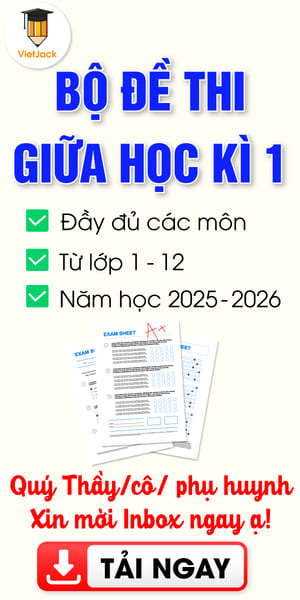Giáo án Tiếng Anh lớp 5 Global Success Unit 4 Lesson 2
Giáo án Tiếng Anh lớp 5 Global Success Unit 4 Lesson 2
Chỉ từ 200k mua trọn bộ Kế hoạch bài dạy (KHBD) hay Giáo án Tiếng Anh lớp 5 Global Success bản word chuẩn kiến thức, trình bày đẹp mắt, dễ dàng chỉnh sửa:
- B1: gửi phí vào tk:
1133836868- CT TNHH DAU TU VA DV GD VIETJACK - Ngân hàng MB (QR) - B2: Nhắn tin tới Zalo VietJack Official - nhấn vào đây để thông báo và nhận giáo án
I. OBJECTIVES
By the end of this lesson, pupils will be able to:
1. Knowledge and skills
- understand and correctly repeat the sentences in two communicative contexts in which characters ask and answer questions about what someone does at the weekend;
- correctly say the words and use What do you do at the weekend? – I ____. to ask and answer questions about what someone does at the weekend;
- use What do you do at the weekend? – I ______. in a freer context;
- understand and correctly use adverbs of frequency always, usually, often, sometimes, rarely, never in relation to the topic “Our free-time activities”.
2. Competences
- Critical thinking and creativity: learn how to ask and answer questions about someone’s free-time activities at the weekend correctly and fluently.
- Communication and collaboration: work in pairs and groups to complete the learning tasks.
- Self-control & independent learning: perform speaking tasks.
3. Attributes
- Explore new interests and develop a healthier and balanced lifestyle, then improve general well-being.
II. MATERIALS
- Pupil’s book: Page 30
- Audio tracks 38, 39
- Teacher’s guide: Pages 66, 67, 68
- Website hoclieu.vn
- Flash cards/ pictures and posters (Unit 4)
- Computer, projector, …
III. PROCEDURES
1. WARM-UP & REVIEW (5 minutes)
a. Objectives
- To revise the words about free-time activities.
b. Content
- Game: Lucky number
c. Expected outcomes
- Pupils can remember and say the words about free-time activities correctly.
d. Organisation
TEACHER’S ACTIVITIES |
PUPILS’ ACTIVITIES |
CONTENT |
Game: Lucky number | ||
|
- Explain that students will play this game in three teams. There are six numbers, they have to choose the number and answer the free-time activity behind the number. If the answer is correct, their team can get the point. The number of candies behind the picture will be the points they get. - Play the game. - Afterwards, ask pupils to read all the words again. |
- Listen to the teacher’s explanation. - Choose the number. - Say the activity revealed behind the number. - Read all the words again. |
Pictures (read stories, water the flowers, ride my bike, surf the Internet, listen to music, play table tennis) |
e. Assessment
- Performance products: Pupils’ pronunciation
- Assessment tools: Observation; Questions & Answers
2. ACTIVITY 1: EXPLORATION (5 minutes)
a. Objectives
- To understand and correctly repeat the sentences in two communicative contexts in which characters ask and answer questions about what someone does at the weekend.
b. Content
- Activity 1. Look, listen and repeat.
c. Expected outcomes
- Pupils can understand and correctly repeat the sentences in two communicative contexts in which characters ask and answer questions about what someone does at the weekend.
d. Organisation
TEACHER’S ACTIVITIES |
PUPILS’ ACTIVITIES |
CONTENT |
Activity 1. Look, listen and repeat. (Track 38) | ||
|
Step 1: Have pupils look at Pictures a and b and identify the characters in the pictures and their activities (see Input). Step 2: Ask pupils to look at Picture a. Play the recording for them to listen. Play the recording again, sentence by sentence, for pupils to listen and repeat. Follow the same procedure with Picture b. Correct their pronunciation where necessary. Step 3: Play the recording again for pupils to listen and repeat in chorus, sentence by sentence. Step 4: Invite a few pairs to the front of the classroom to listen and repeat the sentences in the recording. Step 5: Draw their attention to the question What do you do at the weekend? and the answer I usually listen to music. Tell pupils that they are used to asking and answering about what someone does at the weekend. |
- Pupils look at Pictures a and b and identify the characters and their activities in the pictures. - Pupils look at Picture a and listen to the recording. Pupils listen to the recording again, sentence by sentence, and repeat. Follow the same procedure with Picture b - Pupils follow the teacher’s instructions. - Pairs of pupils come to the front of the classroom to listen to and repeat the sentences in the recording. - Pupils pay attention to the question and the answer. Pupils listen to the teacher’s explanation. |
– Context a: Bill asking Mai about her activity at the weekend Bill: What do you do at the weekend? Mai: I usually listen to music – Context b: Mai asking Bill about his activity at the weekend Mai: How about you, Bill? What do you do at the weekend? Bill: I often play table tennis. |
e. Assessment
- Performance products: Pupils’ performance and pronunciation
- Assessment tools: Observation; Questions & Answers
3. ACTIVITY 2: KNOWLEDGE CONSTRUCTION (10 minutes)
a. Objectives
- To correctly say the words and use What do you do at the weekend? – I ____. to ask and answer questions about what they do at the weekend.
b. Content
- Activity 2. Listen, point and say.
c. Expected outcomes
- Pupils can correctly say the words and use What do you do at the weekend? - I____. to ask and answer questions about what they do at the weekend.
d. Organisation
TEACHER’S ACTIVITIES |
PUPILS’ ACTIVITIES |
CONTENT |
Activity 2. Listen, point and say. (Track 39) | ||
|
Step 1: Have pupils look at Pictures a, b, c and d and elicit the activities of the characters. Step 2: Have pupils point at Picture a, listen to the recording and repeat the words (always / read stories). Point at the bubbles and Picture a again and have pupils listen and repeat after the recording (What do you do at the weekend? - I always read stories.) Step 3: Follow the same procedure with the other three pictures. Have the class repeat the questions and answers a few times. Step 4: Have pairs practise asking and answering the question What do you do at the weekend? - I _____. using the picture cues. Step 5: Invite a few pairs to point at the pictures and say the questions and answers in front of the class. Extension: Introduce two more adverbs of frequency in the chart, which are rarely and never, for pupils to contrast with the other adverbs of frequency they have learnt. Have them make some sentences about someone’s free-time activities at the weekend using the two adverbs of frequency. For example, Thu rarely plays table tennis in her free time. She never goes roller skating in her free time. More practice: Ask pupils to look at the pictures, say the name of the activities. Then, ask them to choose the correct option to complete the answer using adverbs of frequency. Invite a pair of pupils to read the question and answer before moving to the next question. Check their pronunciation. Repeat these steps for the next five questions. |
- Pupils look at the pictures and elicit elicit the activities of the characters. - Pupils point at Picture a, listen to the recording, and repeat the word. Point at the bubbles and Picture a again and listen and repeat after the recording. - Pupils listen and repeat after the recording. Pupils listen and repeat the questions and answers a few times. Pupils follow the teacher’s instructions with Pictures b, c and d. - Pupils work in pairs and practise asking and answering the question What do you do at the weekend? - I _____, using speech bubbles and Pictures a, b, c and d. - Pairs of pupils point at the pictures and say the questions & answers in front of the class. - Pupils listen to teacher’s instructions. Pupils make some sentences about someone’s free-time activities at the weekend using the two adverbs of frequency. - Pupils look at the pictures and say the name of the activities. Choose the correct answer. - Pupils read the question and the answer out loud. |
Picture and word cues: a. a boy reading a story and the words always / read stories underneath b. a girl watering the flowers and the words usually / water the flowers underneath c. a girl riding her bike in the park and the words often / ride my bike underneath <![if !supportLists]>a. <![endif]> d. a boy surfing the Internet and the words sometimes / surf the Internet underneath – Speech bubbles: What do you do at the weekend? – I _____. Audio script:a. always / read stories d. sometimes / surf the Internet b. A: What do you do at the weekend? c. A: What do you do at the weekend? d. A: What do you do at the weekend? Key: 1. I always ride a bike. |
e. Assessment
- Performance products: Pupils’ talks and interaction
- Assessment tools: Observation; Questions & Answers
4. ACTIVITY 3: PRACTICE (8 minutes)
a. Objectives
- To correctly use What do you do at the weekend? – _____. to ask and answer questions about what they do at the weekend in a freer context.
b. Content
- Activity 3. Let’s talk.
c. Expected outcomes
- Pupils can correctly use What do you do at the weekend? – _____. to ask and answer questions about what they do at the weekend in a freer context.
d. Organisation
TEACHER’S ACTIVITIES |
PUPILS’ ACTIVITIES |
CONTENT |
Activity 3. Let’s talk. | ||
Step 1: Ask pupils to look at the picture and elicit the activity each character is doing in the picture. Use the questions What do you like doing in your free time? and What do you do at the weekend? to elicit |
- Pupils look at the picture. Pupils say the actions of the characters in the pictures. Pupils identify the free-time activities of the characters. |
– Picture cues: a girl playing the violin; a boy riding his bike; a boy surfing the net; a girl reading a story |
................................
................................
................................
Trên đây là nguồn học liệu Giáo án Tiếng Anh lớp 5 Global Success miễn phí của NXB Giáo dục Việt Nam. Để xem chi tiết, mời bạn tham khảo: Giáo án Tiếng Anh lớp 5 Global Success (NXB Giáo dục)
Để mua Kế hoạch bài dạy (KHBD) hay Giáo án Tiếng Anh lớp 5 năm 2025 mới nhất, mời Thầy/Cô vui lòng xem thử:
Xem thêm các bài soạn Giáo án Tiếng Anh lớp 5 Global Success (bộ sách Kết nối tri thức) chuẩn khác:
Tủ sách VIETJACK shopee lớp 1-5 (2025):
Đã có app VietJack trên điện thoại, giải bài tập SGK, SBT Soạn văn, Văn mẫu, Thi online, Bài giảng....miễn phí. Tải ngay ứng dụng trên Android và iOS.
Theo dõi chúng tôi miễn phí trên mạng xã hội facebook và youtube:Loạt bài Giáo án Tiếng Anh lớp 5 mới nhất của chúng tôi được biên soạn theo mẫu Kế hoạch bài dạy (KHBD) Tiếng Anh lớp 5 của Bộ GD&ĐT.
Nếu thấy hay, hãy động viên và chia sẻ nhé! Các bình luận không phù hợp với nội quy bình luận trang web sẽ bị cấm bình luận vĩnh viễn.
- Giáo án lớp 5 (các môn học)
- Giáo án điện tử lớp 5 (các môn học)
- Giáo án Toán lớp 5
- Giáo án Tiếng Việt lớp 5
- Giáo án Khoa học lớp 5
- Giáo án Đạo đức lớp 5
- Giáo án Lịch Sử và Địa Lí lớp 5
- Giáo án Tin học lớp 5
- Giáo án Công nghệ lớp 5
- Đề thi lớp 5 (các môn học)
- Đề thi Tiếng Việt lớp 5 (có đáp án)
- Bài tập cuối tuần Tiếng Việt lớp 5(có đáp án)
- Đề thi Toán lớp 5 (có đáp án)
- Bài tập cuối tuần Toán lớp 5 (có đáp án)
- Ôn hè Toán lớp 5 lên lớp 6
- Đề thi Tiếng Anh lớp 5 (có đáp án)
- Đề thi Khoa học lớp 5 (có đáp án)
- Đề thi Lịch Sử & Địa Lí lớp 5 (có đáp án)
- Đề thi Đạo Đức lớp 5 (có đáp án)
- Đề thi Tin học lớp 5 (có đáp án)
- Đề thi Công nghệ lớp 5 (có đáp án)




 Giải bài tập SGK & SBT
Giải bài tập SGK & SBT
 Tài liệu giáo viên
Tài liệu giáo viên
 Sách
Sách
 Khóa học
Khóa học
 Thi online
Thi online
 Hỏi đáp
Hỏi đáp

